Thermaltake Urban T81 Features
Dual Swing Door Design
Inspired by automotive “suicide doors” , the Thermaltake Urban T81’s novel door panels are an innovative and inspired design that sets it apart from any other chassis . Likewise, the front door panel’s brushed aluminum finish masks extrusive drives and devices, producing a unified aesthetic of modern sophistication.
Fully Modular Concept
A highly customizable 5.25″ & 3.5″ drive bay enables users to freely interchange the 3.5″ hard-drive cages to suit one’s need, or remove 5.25″ & 3.5″ drive bays to gain maximum interior space for maximum airflow or the addition of liquid cooling systems.
Sleek I/O Port
The sleek, brushed aluminum I/O port section provides two of the latest SuperSpeed USB 3.0 ports, along with four USB 2.0 ports. The integrated fan hub and controller can easily manage the airflow of up to 10 fans at once. In addition, HD microphone and headset jacks are positioned for easy, direct access when needed.
Supreme Air Cooling System
Urban T81 is built to optimize airflow as part of its fundamental design. Triple 200 mm fans and a 140 mm fan come equipped. It is the first chassis in the market that has the ability to house 4x 200 mm fans, along with three more 120 mm fans – allowing unrivaled airflow to protect your valuable components.
Extensive Liquid Cooling Support
The Thermaltake Urban T81 pushes the envelope by utilizing a high-end water cooling solutions. Featuring support for either front 360 mm/top 420 mm or front 420 mm/top 360 mm radiators, along with rear 120 mm and bottom 120/240 mm radiators, the Urban T81 is an ideal chassis for extreme performance systems.
Extensive Liquid Cooling Support
Urban T81 pushes the envelope and utilize high-end water cooling solution that feature with either front 360/top 420 mm, or front 420 mm/top 360 mm, along with rear 120 mm and bottom 120/240 mm radiators support for extreme performance.
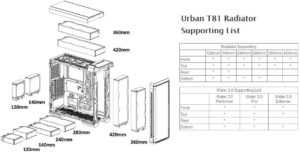
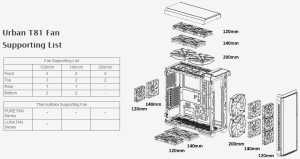
Build and Finished Product
With the ATX motherboard installed, you can feel just how large this chassis really is. While we did rotate the rear fan to clean up some wiring, that was really all we had to do; everything else went in smoothly, and the wiring is simple to figure out and run cleanly.
As for drives, since we already had all of the bays out of the chassis, we used that tray to mount our boot drive. Another bonus to this tray is that it can install where we currently have it, but it will also install just above this location too, allowing you to choose to reduce airflow where it is less needed, since this plate does disturb flow pretty well.
Not too much to discuss around back. The dust shield snapped right in, the card is easily secured out back, and the cover plate screws can be installed from inside for better security. As for the PSU, it is solid and secure, and we noticed no vibrations from it.
With just the basic setup in here, our wiring needs were somewhat limited, but it is easy to see we still have plenty of room to run SATA and Molex leads for drives, or fan power. Also, depending on the cooling setup, there are still six ports free on the fan power hub.
Aside from the view of every component installed into the motherboard compartment of the chassis in their entirety, once we close things up to get ready for testing, we really dig the fact that not much changes from the start; we only see what we truly want: sleek styling, and a great view of the gear.
Without being able to see the blur of the fans currently spinning in the window, it is tough to tell if this chassis is even on. With the LED lighting being at the top, and the complete lack of noise heard from a foot away, this chassis is a pleasure.
As for that lighting, at the top of the chassis you have the LED signifying the fan controller is in the high setting, and if it were in low, the lower LED will illuminate. We did miss the flicker of the HDD activity, but it matches all the rest like the power LED at the front does.
Features and Cooling
The most visually striking feature in the Urban T81 is the windowed side panel. Thermaltake has tried something new with the Urban T81 that sounds like it could be a case modder’s dream project: splitting the side panel in two and hinging both pieces. We’ve seen hinged doors before, such as on the even more immense Cooler Master Cosmos II, in which both side panels are hinged along the front edge. Where the Urban T81 differentiates itself is that the rear, windowed portion of the panel opens in reverse (that is, to the back) and the forward portion opens to the front…
The doors are held in place via a heavy rail that’s lockable with an included pair of keys. Once unlocked, the doors stay shut, only releasing via a button underneath the case that pushes the rail up. We appreciate that doors this heavy aren’t secured with some kind of gimmicky magnet and instead use a mechanical spring and rail that feels rugged and posh.
We did notice the doors don’t swing outward quite the same amount. The windowed (left) door swings well past 180 degrees, allowing for easy access to the motherboard and power-supply (PSU) area to build or tinker. The door covering the drive bays, however, only opens to roughly 90 degrees, and it takes a hand to keep it open that far. It’s not a problem per se, but it seemed a bit out of sync with the left-hand door when both were open wide.
The last few cases we’ve looked at have been geared toward builders with smaller budgets, and part of the way they hit their price points was to cut out some of the cooling gear. With the Urban T81, on the contrary, Thermaltake budgeted for plenty of fans—indeed, it perhaps budgeted for overkill. While the cooling highlight of many mondo PC cases is one big 200mm fan mounted up front, the Urban comes with three of these pie-size fans installed. Two are behind individually removable filters behind the front door…
The third is top-mounted, underneath two separate filters. Here, you can see it with the top and side panels of the case removed…
And Thermaltake also included a 140mm exhaust fan out back for good measure…
The Urban T81 can support up to nine fans, but that would require replacing all of the included fans (barring the rear exhaust) with 120mm variants. Realistically, for a pure air-cooling scenario, we could see adding two more fans: another 200mm one to the top, and one 140mm to the bottom, in front of the power supply, to help ventilate the graphics-card area. But what you get stock is plenty.
For fan-wiring flexibility, Thermaltake has added a fan hub to the back side of the motherboard tray, an innovation we have seen earlier on some higher-end NZXT cases…
Running fan wires behind the motherboard tray is a big help to keep things neat. This hub can supply power to a total of 10 fans at once—one more than can actually fit inside the case! The entire hub is then wired to a simple high-low fan-speed controller on the top of the case, to the left of the USB ports. This is less appealing, in that you can’t control individual fans or clusters of fans separately. It’s all fast, or all slow, if you use the hub.
Of course, in a case this big, liquid cooling might be what you have in mind instead, and here the Urban T81 can really shine. All that interior space allows for some really outlandish potential: This case can support two 420mm radiators, a 280mm radiator, and an 140mm radiator all at the same time. The massive 420mm radiators would be split between the top and the front of the case. The smaller 280mm radiator unit would fit in on the floor of the case, just in front of the PSU, while the smallest unit would replace the 140mm exhaust fan. Of course, you could mount a smaller radiator in any of those spots instead, and you certainly don’t need to install four.
You might be wondering how all of those cooling loops could fit in the case at once, even one this big. To that question, we urge you to keep reading, since the drive bays have a lot to do with that.
Final Thoughts
There are only two tiny factors that we could even find «odd» about the Urban T81 chassis. The first is doing away with tie points for the most part, and only offering some small holes here and there for straps, and the tab system. While we could tend wiring easily enough, we in no way attempted to maximize its potential. With all of those components needed to power a loop or two, we would like a way to keep all of that clean as well. The second thing is less of an oddity, but is something to keep in mind. While the back panel covered our wiring without issue, the panel is so large that it flexes quite a bit, and ours required us to lay the chassis down, and use our hands and forearms to level the panel to get it installed. Outside of that, we honestly have not one complaint about what the Urban T81 offers in its basic feature set, or the way the modular systems work, nor did we see any issues getting anything within reason installed into this chassis.
We only scratched the surface of what this chassis is capable of doing, and with our images and system, it looks like a much smaller system is installed. However, once you take into consideration that you can hang very thick radiators at the top, with fans above the chassis, and still not run into the motherboard, you will realize the true magnitude of the Urban T81. There is also plenty of room for 30mm radiators, and push/pull fan setups. As for the potential up front, that all depends on your specific needs. You could leave the ODD bays in, and a rack for the HDDs, or you can completely gut the front of the chassis as we did, and allow for maximum room and air flow.
Speaking of which, while the chassis is empty up front, we have no complaints about the air flow; in fact, things were nice and chilly in our testing. However, when we began adding the bays back in, we saw the temperatures increase as we added more of them. The low speed fans supplied are fair, but once impeded upon, they lose effectiveness pretty fast.
Thermaltake has shown us that they really have their ear on the market with a chassis such as this. The Thermaltake Urban T81 is a flagship design, and it definitely shows that Thermaltake is out there to offer a chassis that will thrive, since it does almost anything you ask of it so well. While we have seen others that can do similar things with water cooling, we have not yet seen it in a chassis quite like this. While it is large and in charge, the Urban T81 provides a great opportunity for beginners to invest into something elegant and quiet. It will also allow users to take PC cooling to levels as far as their experience and nerve will allow over time, drastically expanding the initial investment.
For enthusiasts, you know what you need in a chassis design to install an existing loop. But, for those who have a plan for a loop or two, and need plenty of options and modularity in a structurally sound design to make it happen, then the Urban T81 might just be the perfect fit for you. The fact that it looks so good, doesn’t disturb you with ear splitting noise levels, and that it can and will house a ton of gear, all spices up the deal when it comes to that near $175 price point.
PRICING: You can find the THERMALTAKE URBAN T81 for sale below. The prices listed are valid at the time of writing, but can change at any time. Click the link to see the very latest pricing for the best deal.
United States: The THERMALTAKE URBAN T81 retails for $172.24 at Amazon.
Canada: The THERMALTAKE URBAN T81 retails for CDN$218.88 at Amazon Canada.
1234
Packaging
A plain cardboard box is nice to see, as it shows your money is invested into the chassis, and not some fancy box you are going to throw away. On this front panel we simply get black printing applied to show off the product naming, and a rendering of the chassis.
The right side offers us the same, very descriptive, specifications chart to show someone in a retail setting the true capabilities of this design.
After another spin of the packaging, we find the front and back panels to be identical, even down to the web address at the bottom.
The last panel offers a features list of sorts in twelve languages. This is where they cover the front I/O connectivity, the trio of 200mm fans they have installed, the modular drive bay design, and the fact this chassis is completely water cooling capable.
The chassis is actually facing the wrong way in this image, but under the thick Styrofoam end caps used to protect the chassis from drops and bangs as it is shipped, we also see it comes in a cloth bag. In fact, this is the same cover used on the Level 10GT, as the naming printed on it clearly shows. Not only does it protect the chassis from scratches during transit to your door, but it also makes a nice cover when going to a LAN, or a buddy’s house.
Accessories and Documentation
We were given five adjustable ties straps to help with the wire management, hence the round holes. We also get a handful of metric screws for SSD and ODD installation, HDD screws in plenty, and another handful of 6-32 screws for the motherboard. At the bottom are two sets of fan screws in varying lengths for the top and front of the chassis. We also get a socket and a few standoffs, PSU screws, and a set of regular fan mounting screws.
What we have here is also included in the box. There is an 8-pin EPS extension cable provided since this chassis is so tall. This is also able to be broken down to a single 4-in for lower power draw motherboards. We also get a motherboard speaker to hear beep codes, and a pair of brackets to convert a 5.25″ bay for use with a 3.5″ device.
This bracket is the one from just behind the HDD racks. This uses tabs on the left side of the chassis to hook into the spring loaded rail for the doors. At the right of the chassis, it is held in with simply a thumbscrew. What makes this really cool is that even with the SSD we chose to mount here, you can still put a 3.5″ drive over the top and store two drives on this rack at once, limiting the need for all those cages.
Under the Styrofoam there is a bag containing the paperwork we have here. This is the manual that takes you from the checklist, on through to each and every step of the installation process. While we found the images to be very self explanatory, the text provided will answer any questions that may arise. Next to it is the warranty guide detailing what is covered in the warranty term of one year.
We realize that many users need the visual of what is going on to fully understand what the charts were trying to point out. This page says it all when it comes to cooling and fan options inside of this chassis.
Thermaltake Urban T81 Specifications
| Model | Urban T81 |
| Product Number | CA-1B7-00F1WN-00 |
| Case Type | Full Tower |
| Dimension (H x W x D) | 585 x 235 x 602 mm (23 x 9.3 x 23.7 inch) |
| Net Weight | 13.8 Kg / 30.4 lb |
| Side Panel | Transparent Window |
| Color | Exterior & Interior : Black |
| Material | SECC |
| Cooling System | Front (intake) : 200 x 200 x 30 mm fan (600~800rpm, 13~15dBA) x 2 Rear (exhaust) : 140 x 140 x 25 mm Turbo fan (1000rpm, 16dBA) Top (exhaust) : 200 x 200 x 30 mm fan (600~800rpm, 13~15dBA) |
| Drive Bays | -Accessible : 2 x 5.25’’,1 x 3.5’’ (Converted from one 5.25” drive bay) -Hidden : 8 x 3.5’’ or 8 x 2.5’’ |
| Expansion Slots | 8 |
| Motherboards | 9.6” x 9.6” (Micro ATX), 12” x 9.6” (ATX), 12” x 13” (Extend ATX) |
| I/O Port | USB 3.0 x 2,USB 2.0 x 4, HD Audio x 1,Fan Speed Control |
| PSU | Standard PS2 PSU (optional) |
| LCS Upgradable | Supports 1/2”、3/8”、1/4” water tube |
| Fan Support | Front: 1 x 120mm or 2 x 120mm or 3 x 120mm 1 x 140mm or 2 x 140mm 1 x 200mm or 2 x 200mm Top: 1 x 120mm or 2 x 120mm or 3 x 120mm 1 x 140mm or 2 x 140mm 1 x 200mm or 2 x 200mm Rear: 1 x 120mm or 1 x 140mm Bottom: 1 x 120mm or 2 x 120mm 1 x 140mm or 2 x 140mm |
| Radiator Support | Front: 1 x 120mm or 1 x 240mm or 1 x 360mm 1 x 140mm or 1 x 280mm or 1 x 420mm Top: 1 x 120mm or 1 x 240mm or 1 x 360mm 1 x 140mm or 1 x 280mm or 1 x 420mm Rear: 1 x 120mm or 1 x 140mm Bottom: 1 x 120mm or 1 x 240mm 1 x 140mm or 1 x 280mm |
| Other | CPU cooler height limitation: 180mm VGA length limitation: 360mm(with HDD rack) 400mm(without HDD rack) |
Thermaltake Urban T81 Full-Tower Chassis
The front of the Urban T81 may look slightly offset to the left, but that is due to the angular edge used at the right. The door that covers the front of the case wraps around the left edge, and offers a brushed aluminium texture from the top, down to the Thermaltake logo at the bottom.
Opening the door, we reveal the two 5.25″ drive bay covers that can be removed without having to pull the bezel. Below that we see a slotted section of ventilation, and at the bottom is a pop-out dust filter for easy cleaning.
The top of the chassis has an insert to match the brushed aluminum aesthetic we saw on the front to contain the front I/O. The rest of the top is covered with a tall plastic frame, and the mesh we see here now can also be easily popped out for access, and cleaning.
The front I/O offers a ten port fan controller, reset button, HDD LED, and Power button with built-in LED at the left. As we move to the right, we see 3.5mm audio jacks, four USB 2.0 ports, and a pair of USB 3.0 ports. Above them is an arrow, and pushing this will release the clip holding the mesh panel in.
The left side of the chassis offers a three-quarter door at the left with a clear window, and a great view inside. The other quarter panel at the front covers all of the drive bays, and we see a lock keeping them shut. We can also see that the side of the bezel is where the air flows through to cool the interior.
Opening the doors is a two-step process. First, you need the keys from the back of the chassis to unlock the panels as the painted on instructions show.
After unlocking them, you will need to locate the switch under the chassis that the «push» painted at the bottom of the panel implies. This raises a spring loaded lever that raises pins out of key ways to let them swing out freely.
The back of the chassis has tons going on as well. The top can be fully removed for fan swaps, just above where the keys are hanging, and the water cooling grommets are. There is the exhaust fan next to the I/O as we expect, then eight expansions slots accessed from here, and a bottom mounted PSU. There is also a couple of cord tending clips for extra security.
The right side of the chassis is a large expanse of steel with a bump in it that is 3mm deep. While this will allow for some extra wiring, it isn’t as deep as most others’ who offer this feature.
Under the chassis there are large ABS feet with long rubber strips applied to keep it solidly footed on any surface. Inside of the feet there is one long dust filter that covers the PSU, and the optional fan location. We also see the door release button again, just behind the top front foot.
Особенности и охлаждение
Наиболее яркой особенностью Urban T81 является оконная боковая панель. Компания Thermaltake опробовала что-то новое с Urban T81, которое звучит так, как будто это проект мечты модератора: разделить боковую панель на две части и установить обе части. Мы уже видели навесные двери, например, на еще более огромном Cooler Master Cosmos II , в котором оба боковые панели откидываются вдоль переднего края. Отличительной особенностью Urban T81 является то, что задняя оконная часть панели открывается в обратном направлении (то есть назад), а передняя часть открывается вперед…
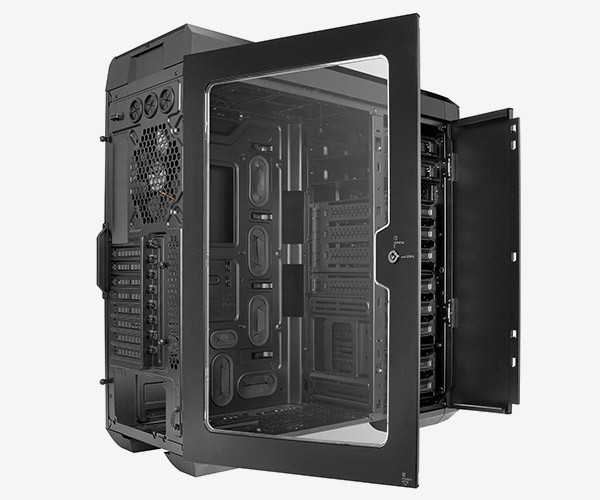
Двери удерживаются на месте через тяжелый рельс, который запирается с помощью прилагаемой пары ключей. После разблокировки двери остаются закрытыми, открывая их только через кнопку под корпусом, которая толкает направляющую вверх. Мы ценим, что эти тяжелые двери не защищены каким-то хитрым магнитом, а вместо этого используем механическую пружину и рейку, которая кажется прочной и шикарной.
Мы заметили, что двери не выглядят одинаково. Оконная (левая) дверь поворачивается далеко на 180 градусов, что обеспечивает легкий доступ к области материнской платы и блока питания (PSU) для сборки или повозки. Дверца, закрывающая отсеки для дисков, открывается только примерно на 90 градусов, и требуется рука, чтобы держать ее открытой так далеко. Само по себе это не проблема , но казалось, что он немного не синхронизирован с левой дверью, когда оба были широко открыты.
Последние несколько случаев, на которые мы смотрели, были ориентированы на строителей с меньшими бюджетами, и часть того, как они достигли своей цены, заключалась в том, чтобы отключить некоторые охлаждающие устройства. С Urban T81, напротив, Thermaltake заложила в бюджет много поклонников — в действительности, возможно, излишне. В то время как охлаждение многих корпусов Mondo PC — один большой 200-миллиметровый вентилятор, установленный спереди, Urban поставляется с тремя из этих установленных круглых вентиляторов. Два позади индивидуально сменных фильтров позади передней двери…
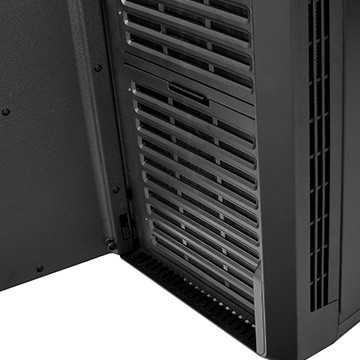
Третий — сверху, под двумя отдельными фильтрами. Здесь вы можете увидеть это со снятой верхней и боковой панелями корпуса…
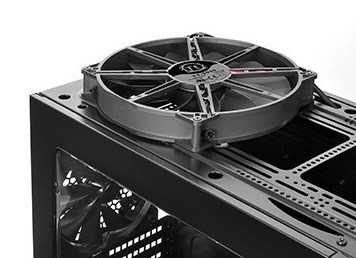
И Thermaltake также включил 140-мм вытяжной вентилятор сзади для хорошей меры…
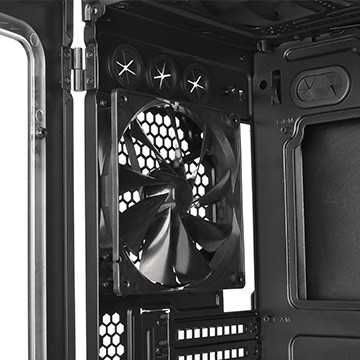
Urban T81 может поддерживать до девяти вентиляторов, но для этого потребуется заменить все включенные вентиляторы (за исключением заднего выхлопа) на 120-мм варианты. Реально, для сценария с чистым воздушным охлаждением, мы могли бы добавить еще два вентилятора: еще один 200 мм сверху и один 140 мм снизу перед источником питания, чтобы вентилировать область видеокарты. Но то, что вы получаете на складе, достаточно .
Для обеспечения гибкости подключения вентиляторов компания Thermaltake добавила концентратор вентилятора на задней стороне лотка материнской платы, новшество, которое мы видели ранее для некоторых корпусов NZXT более высокого класса…
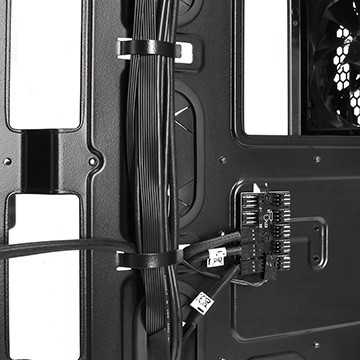
Прокладка проводов вентиляторов за лотком материнской платы — большая помощь, чтобы держать вещи опрятными. Этот концентратор может одновременно подавать питание на 10 вентиляторов — на один больше, чем может поместиться внутри корпуса! Затем весь концентратор подключается к простому контроллеру скорости вращения вентилятора в верхней части корпуса слева от портов USB. Это менее привлекательно, потому что вы не можете управлять отдельными поклонниками или группами поклонников отдельно. Это все быстро или все медленный, если вы используете концентратор.
Конечно, в кейс Это большое жидкостное охлаждение может быть тем, что вы имеете в виду, и здесь Urban T81 действительно может сиять. Все это внутреннее пространство учитывает какой-то необычный потенциал: этот корпус может поддерживать два 420-мм радиатора, 280-мм радиатор и 140 мм радиатор все одновременно. Массивные 420 мм радиаторы будут разделены между верхней и передней частью корпуса. Меньший 280-миллиметровый радиатор поместился бы на полу корпуса прямо перед блоком питания, в то время как самый маленький блок заменил бы 140-мм вытяжной вентилятор. Конечно, вы можете установить радиатор меньшего размера в любом из этих мест, и вам не нужно устанавливать четыре.
Вы можете быть удивлены, как все эти контуры охлаждения могут поместиться в корпусе, даже один такой большой. На этот вопрос мы настоятельно рекомендуем вам продолжить чтение, поскольку отсеки для дисков во многом связаны с этим.
Conclusion
Casual builders beware: The Thermaltake Urban T81 is a massive gorilla of a case, and it’s probably much more than you need. It can cool a modest-to-big configuration rather quietly just on air, thanks to its three big 200mm fans, but it provides so much space that you should be sure you really need it all before diving in. If you’re not planning on installing multiple water-cooling loops for your CPU and several video cards, you’ll end up with big parts of the Urban empty, unless you happen to own an immense stack of hard drives that you’ve been migrating from PC to PC.
The reverse-open, hinged side panels are an unusual design touch, and we think, an interesting take on how to access the innards on a massive case without making you wrestle with one big, unwieldy side panel. Hinges usually also mean two less thumbscrews to worry about losing, but in this situation these screws are replaced by a pair of keys. Thermaltake had the foresight to make the use of the keys optional, and we love the door locking mechanism.
The styling on the Urban T81 feels like it’s going in a more premium direction from the Urban S71, which is a good thing. We’re hoping that when the Urban U91 (we’re guessing on that name) is released, that the ABS plastic is gone for good. But otherwise, in the here and now, you should short-list the T81 if you have massive aspirations in your next PC build or case upgrade. It will meet them and exceed them.
Thermaltake Urban T81
4.0
(Opens in a new window)
See It
$209.99 at Office Depot & OfficeMax
(Opens in a new window)
MSRP $189.99
Pros
- Minimalist styling.
- Lots of space for drives and cooling mechanisms.
- Many mounting points for liquid coolers.
- Dual-door design.
View More
Cons
- Chassis doors have limited movement.
- Plastics detract from premium feel.
The Bottom Line
A juggernaut of a PC case, Thermaltake’s Urban T81 can house nearly any mix of parts, plus loads of water-cooling gear—and not think twice about it. This mega-tower is ideal for an extreme PC build.
Like What You’re Reading?
Sign up for Lab Report to get the latest reviews and top product advice delivered right to your inbox.
This newsletter may contain advertising, deals, or affiliate links. Subscribing to a newsletter indicates your consent to our Terms of Use and Privacy Policy. You may unsubscribe from the newsletters at any time.
Thanks for signing up!
Your subscription has been confirmed. Keep an eye on your inbox!
Sign up for other newsletters
Внутреннее пространство
Внутри корпуса Thermaltake Urban S41 довольно просторно. По заявлению производителя сюда можно установить материнскую плату стандарта АТХ и даже Е-АТХ, что очень похвально для корпусов подобного класса.
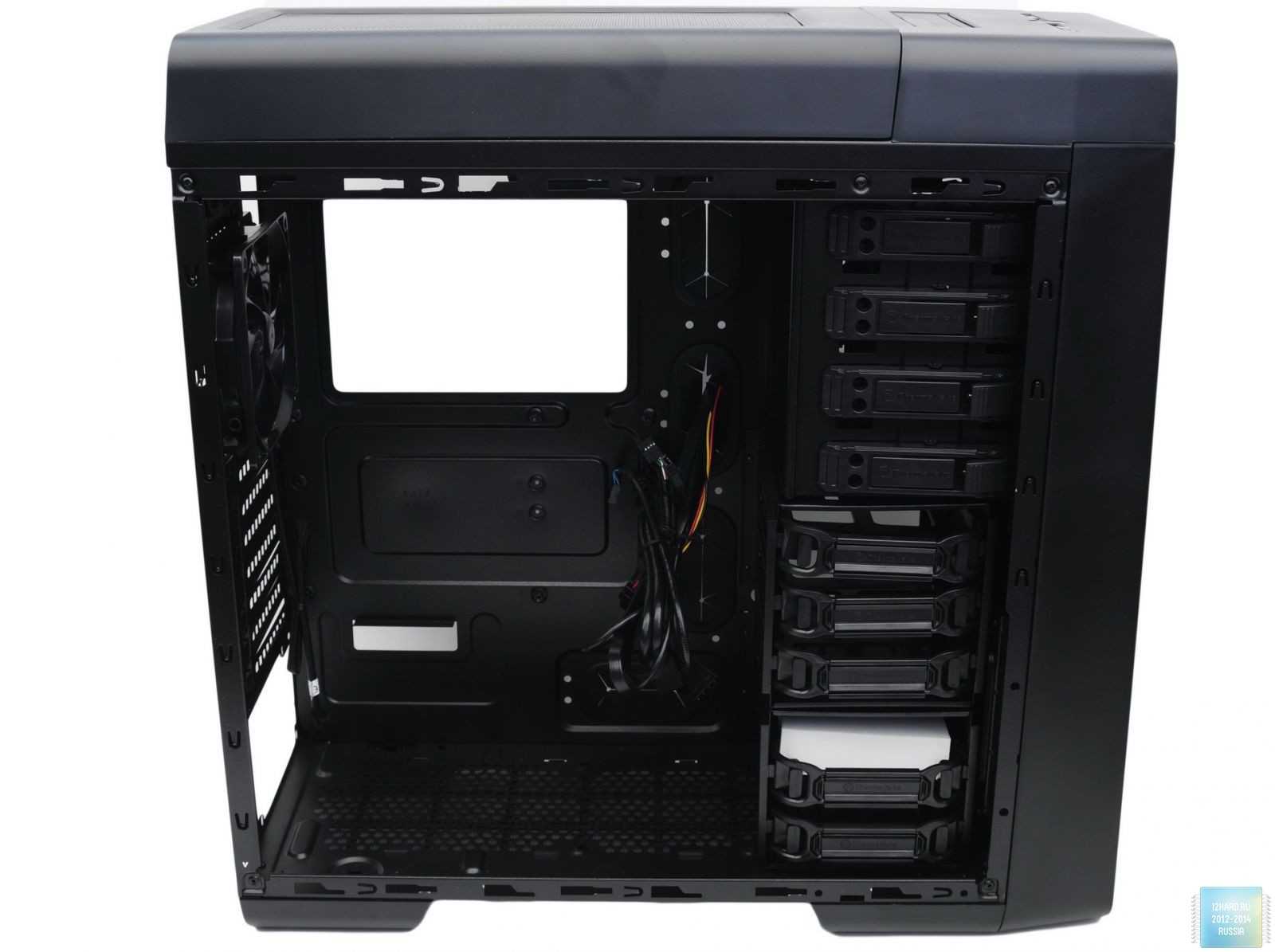
В поддоне корпуса имеются отверстия для прокладки проводов, которые закрыты резиновыми заглушками.
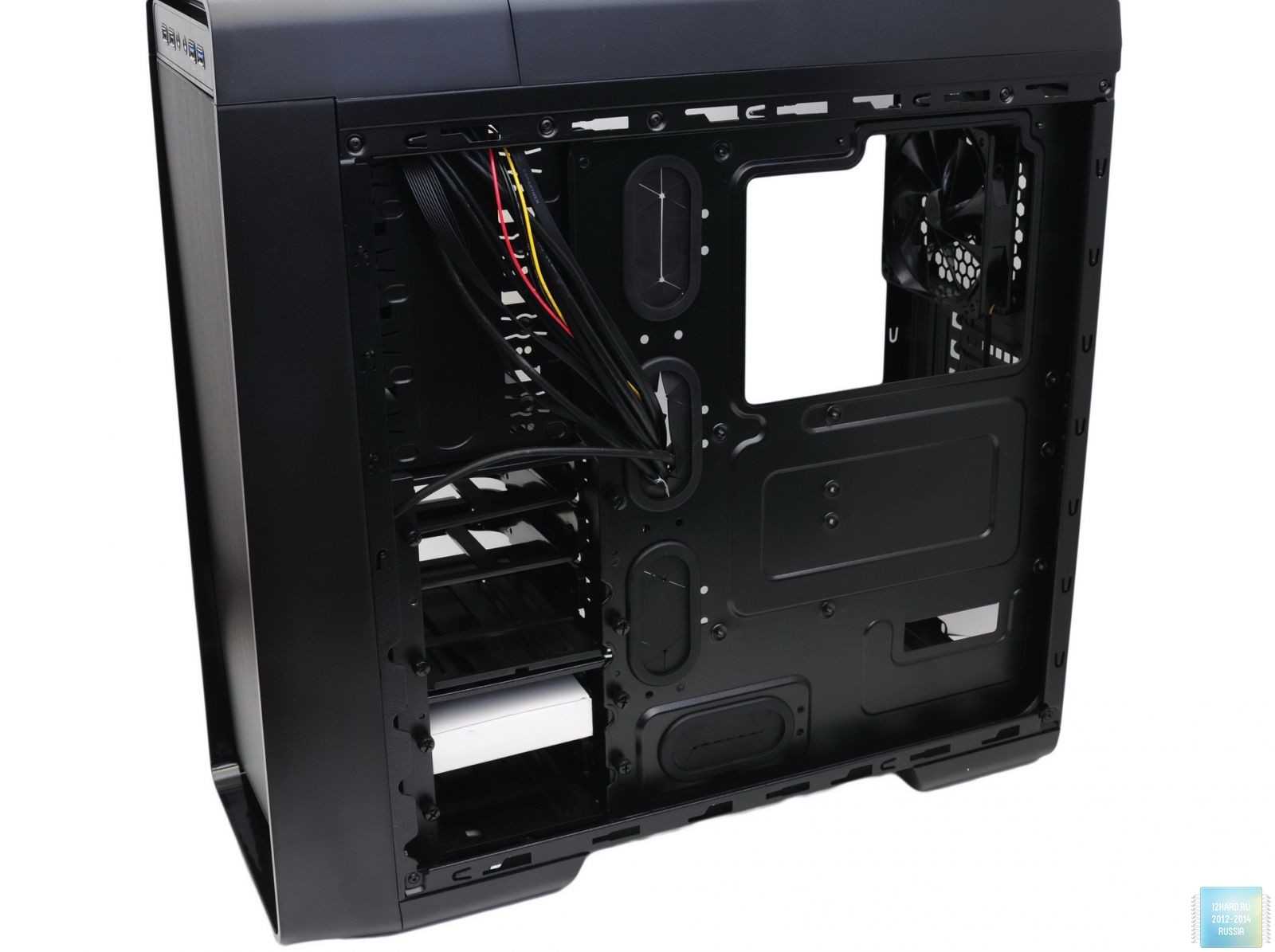
Также поддон, за счет большого отверстия в центре, дает возможность смены системы охлаждения для центрального процессора без снятия самой материнской платы.
Все отсеки 5,25″ снабжены безвинтовыми фиксаторами для быстрого монтажа или демонтажа устройств.
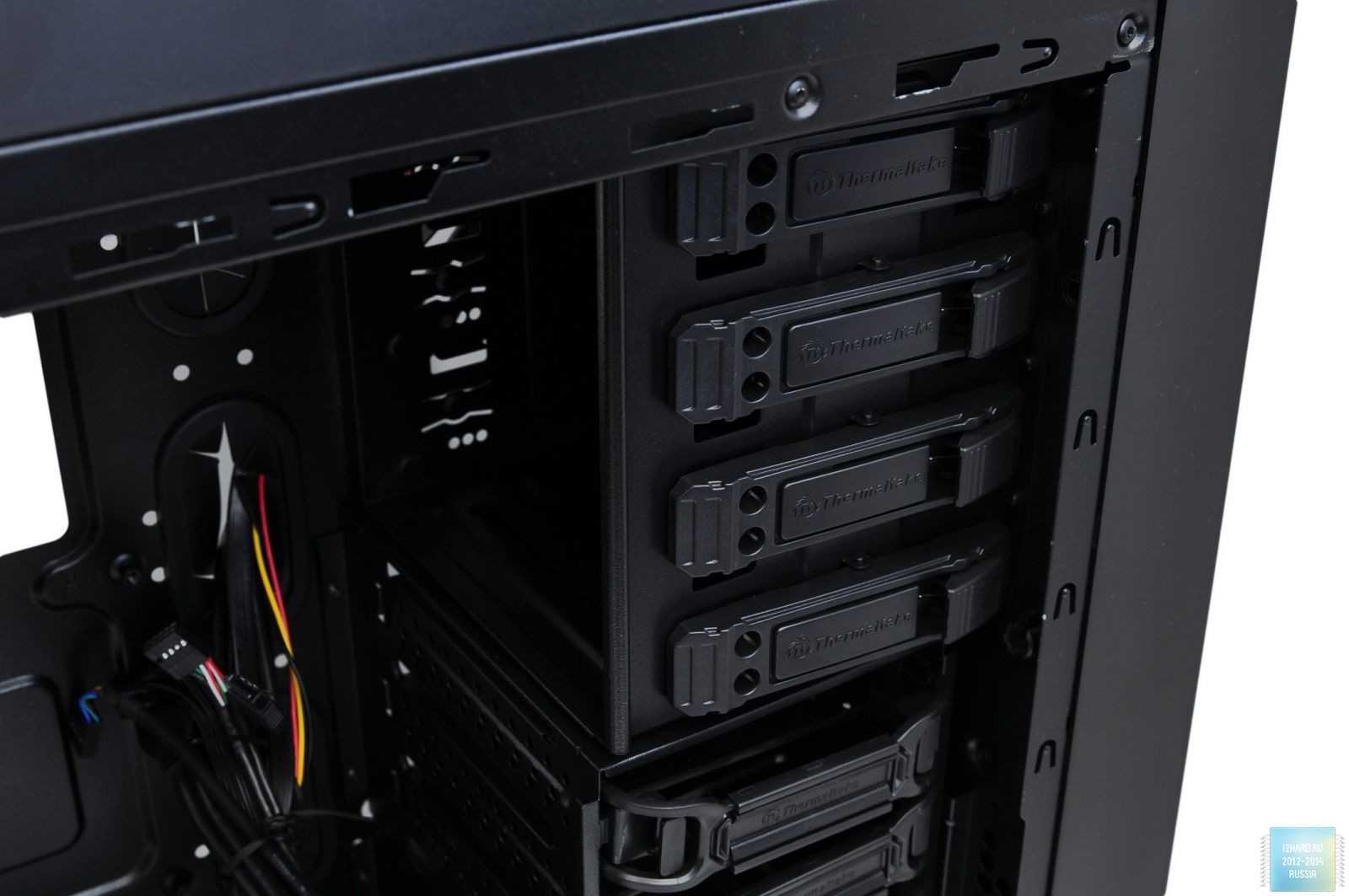
Корзин для HDD накопителей здесь две. Верхняя корзина позволяет установить три HDD накопителя, а нижняя – два.
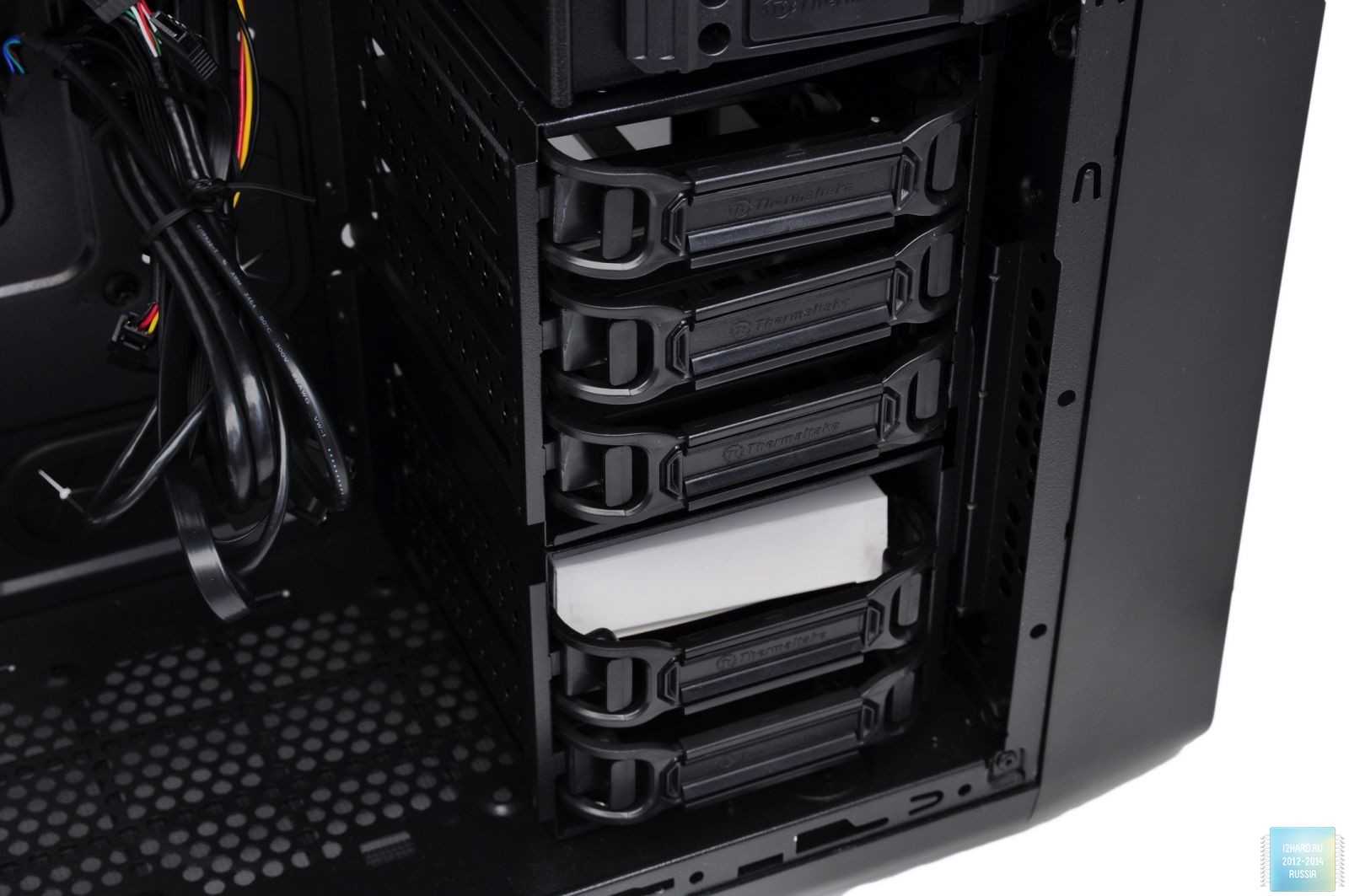
Корзины снабжены пластиковыми салазками, которые способны принять как накопители размером 3,5″ так и 2,5″.
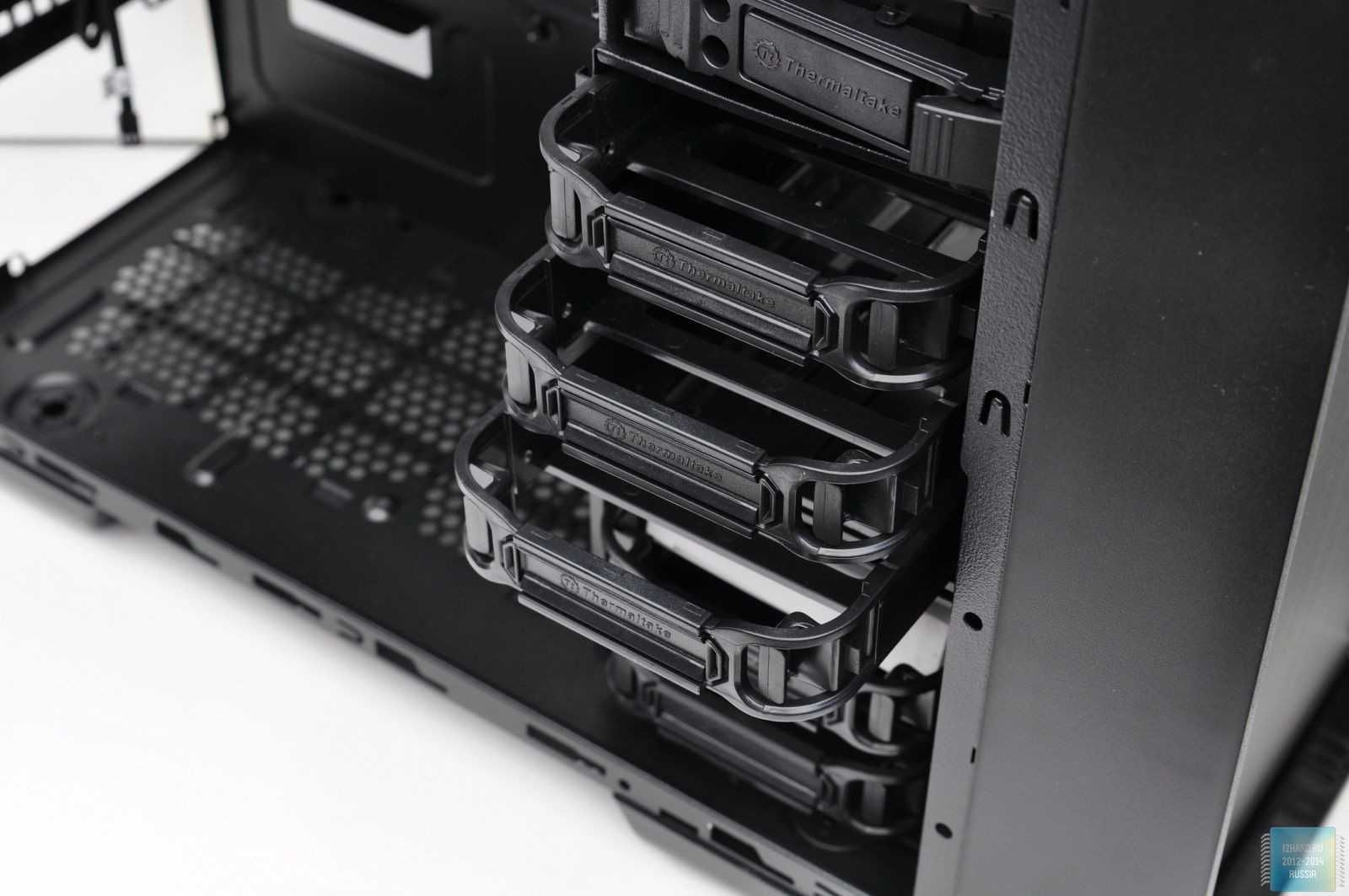
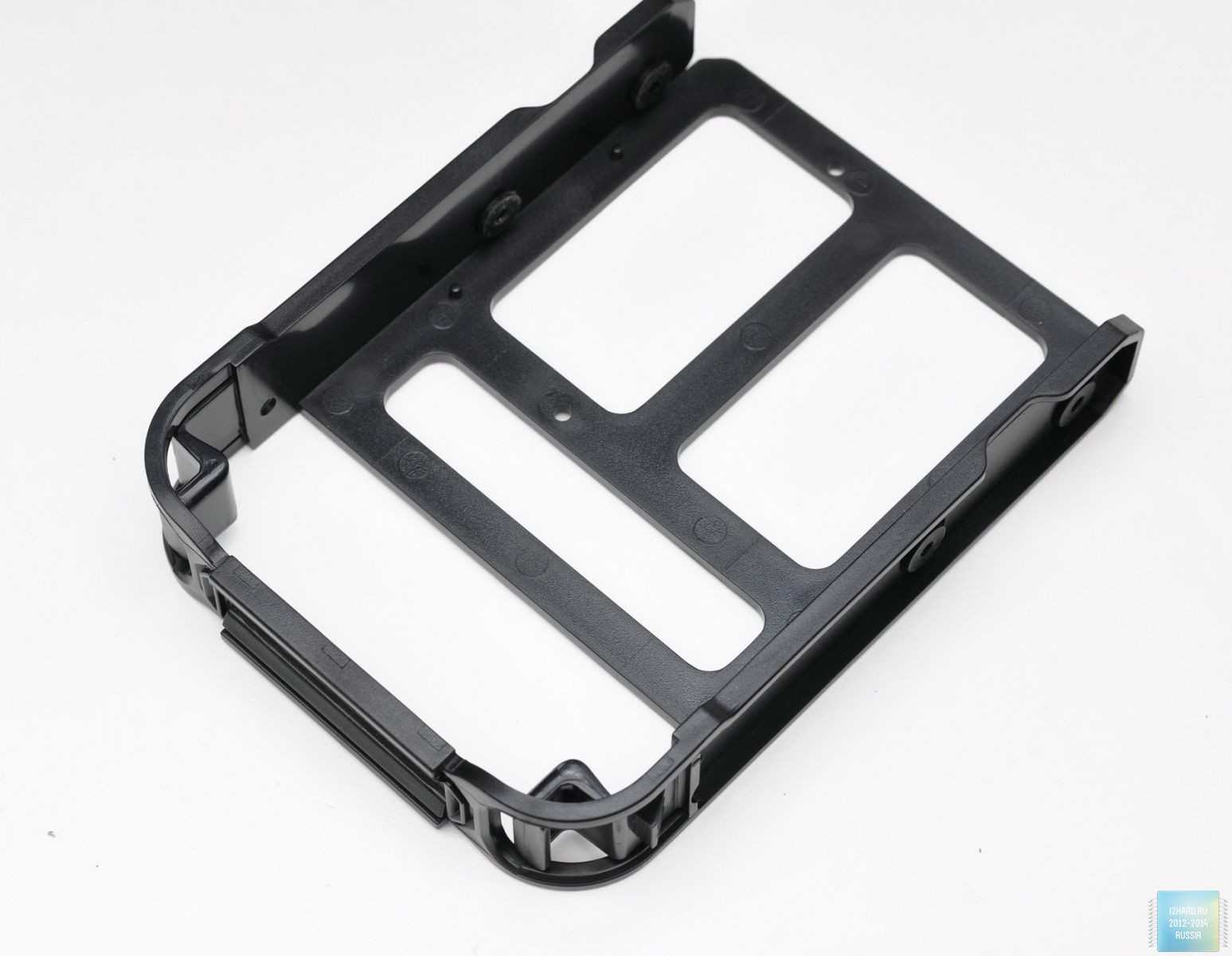
Хочу также отметить, что на одни салазки можно одновременно установить HDD накопитель 3,5″ и SSD накопитель 2,5″.
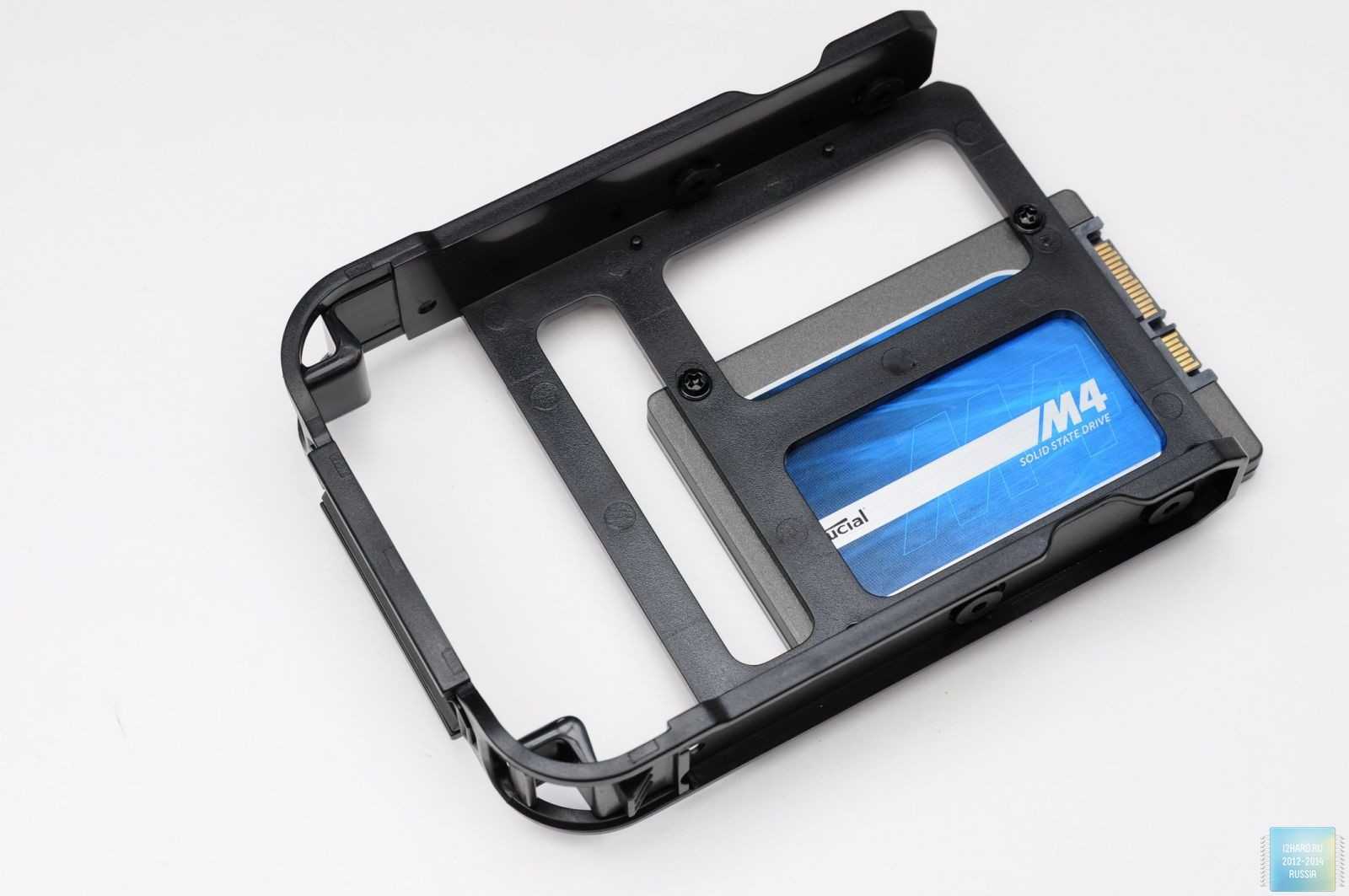
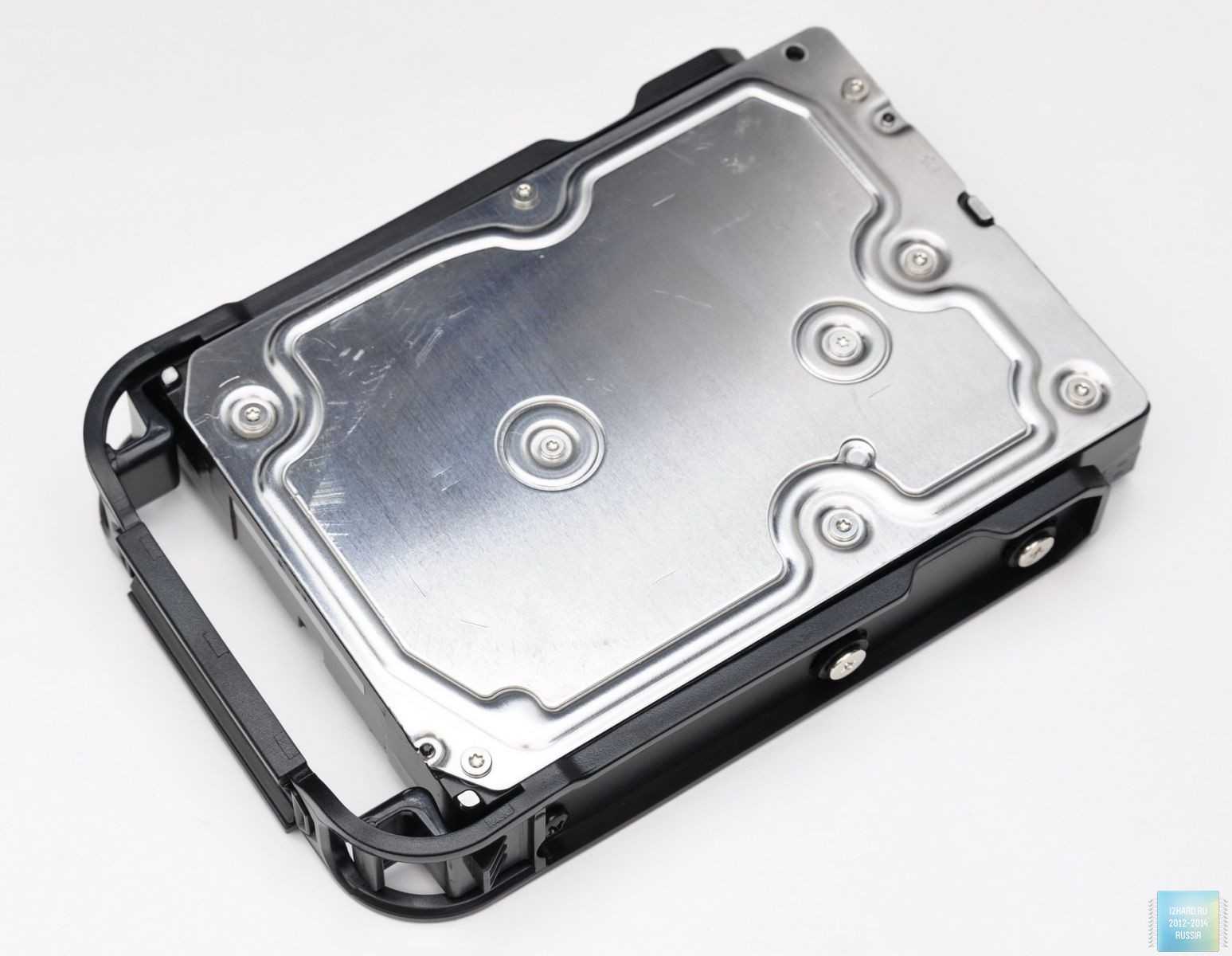
Сами же корзины для HDD съемные, при желании можно демонтировать одну из них для улучшения циркуляции воздушного потока внутри корпуса. Для этого необходимо открутить несколько винтов с накатанной головкой с задней стороны поддона, а так же с внутренней стороны самой корзины.
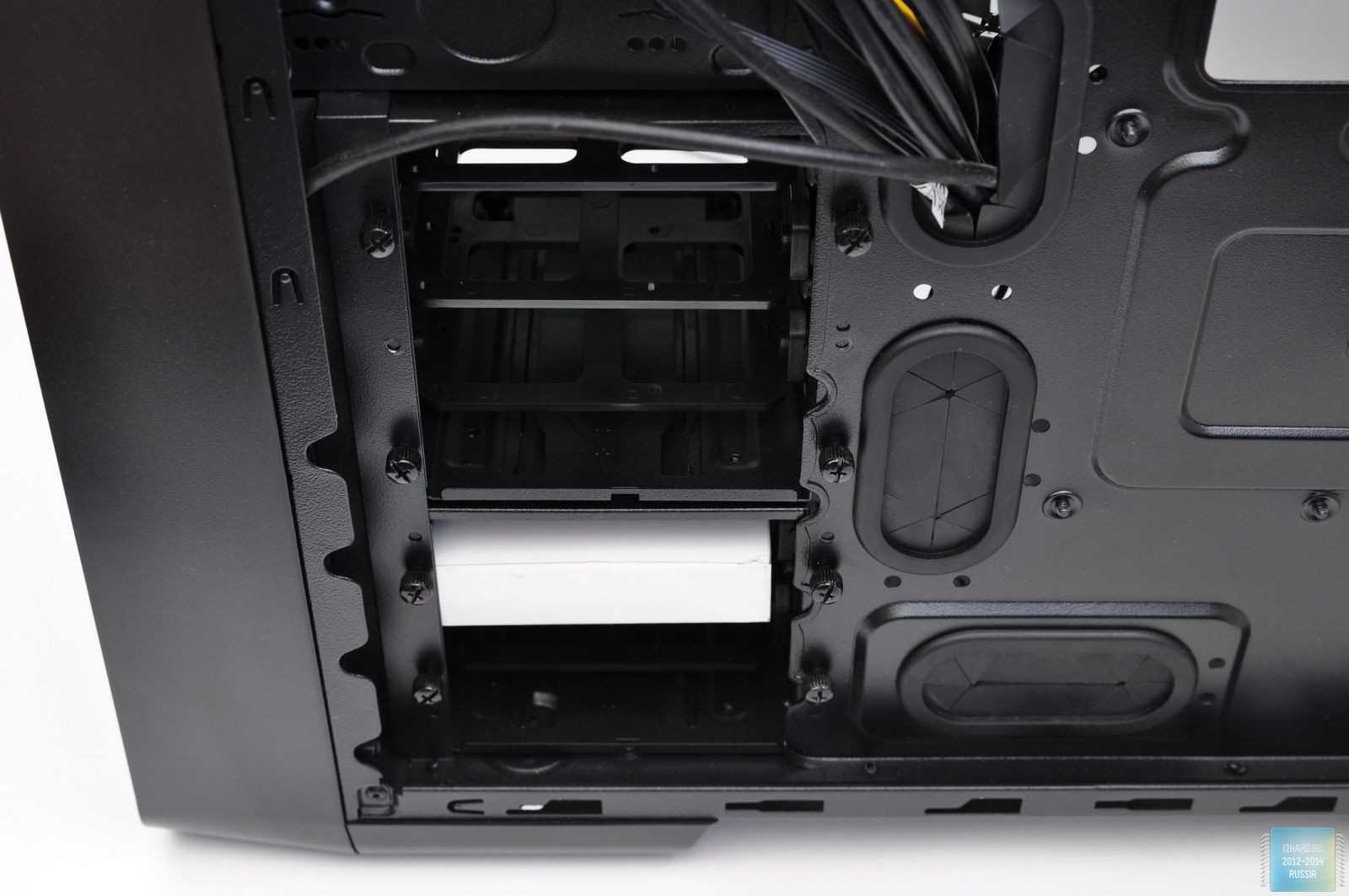
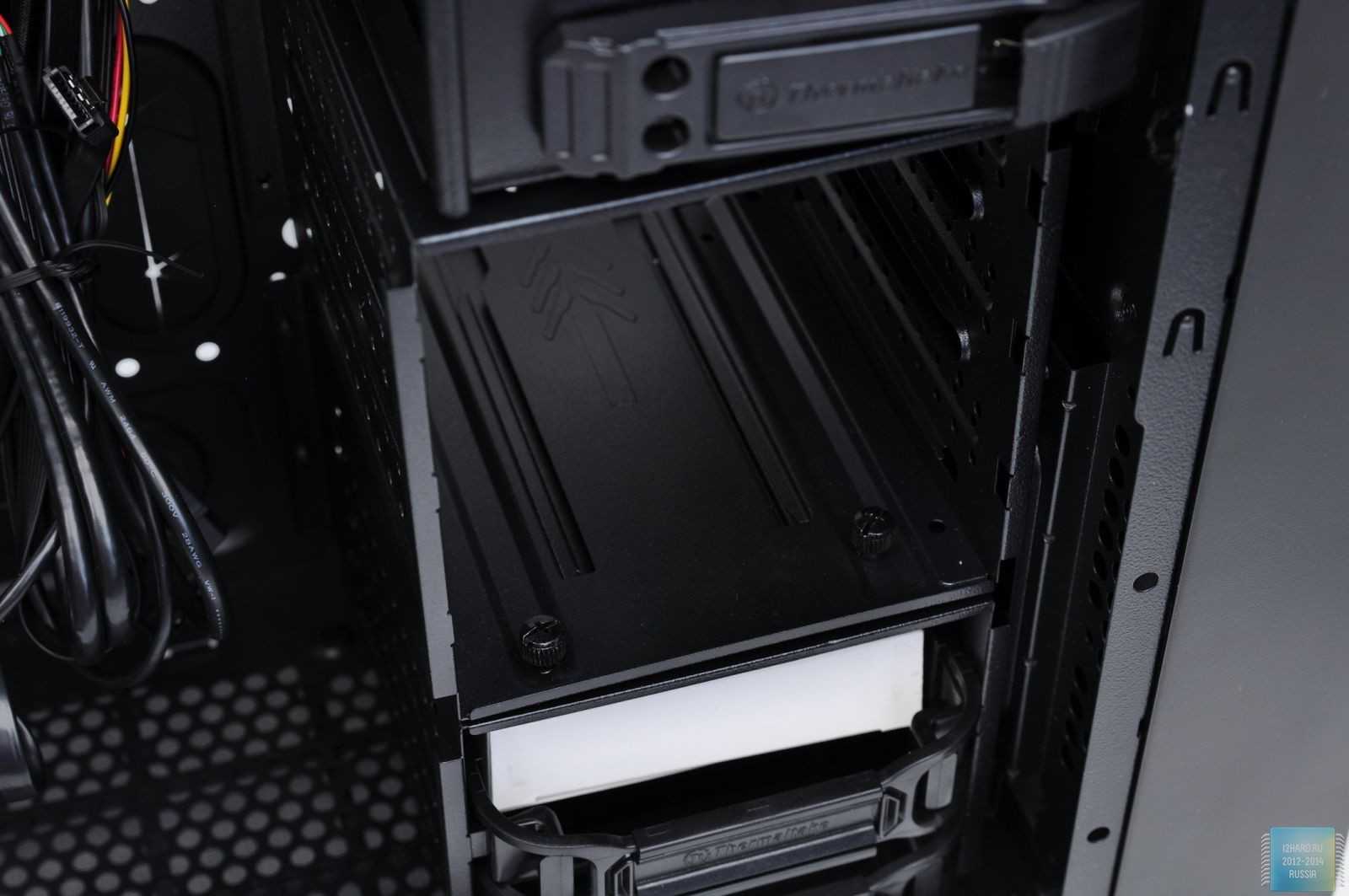
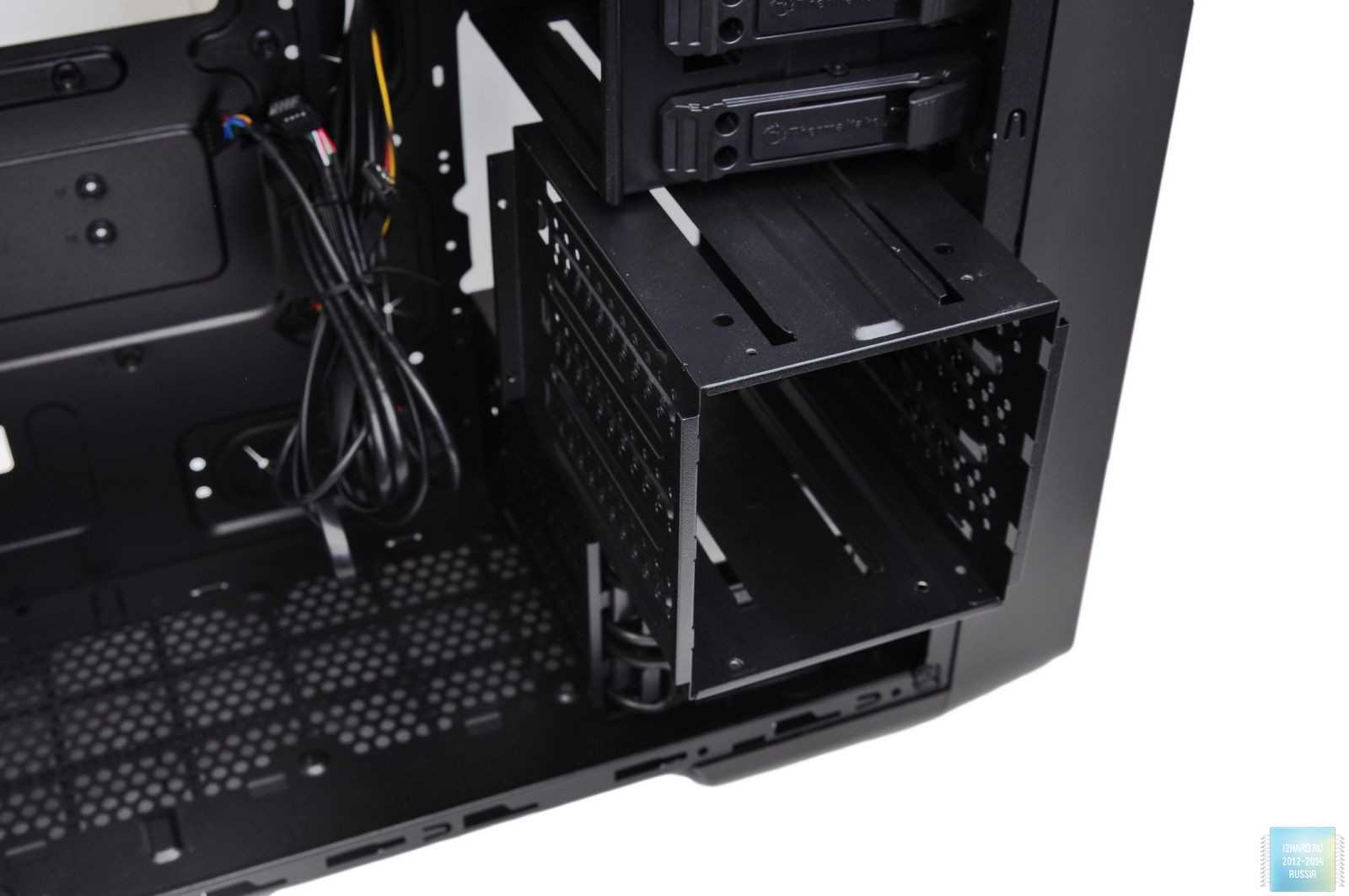
После демонтажа корзины HDD нас опять ждет неприятный сюрприз, связанный с поддоном для материнской платы. Из-за недостаточной толщены поддона и отсутствия у него ребер жесткости, при демонтаже корзины теряется жесткость конструкции корпуса, в результате чего поддон прогибается во время монтажа материнской платы.
Упаковка и комплектация
Корпус упакован в картонную коробку, на лицевой стороны которой имеется изображение фрагмента самого корпуса.
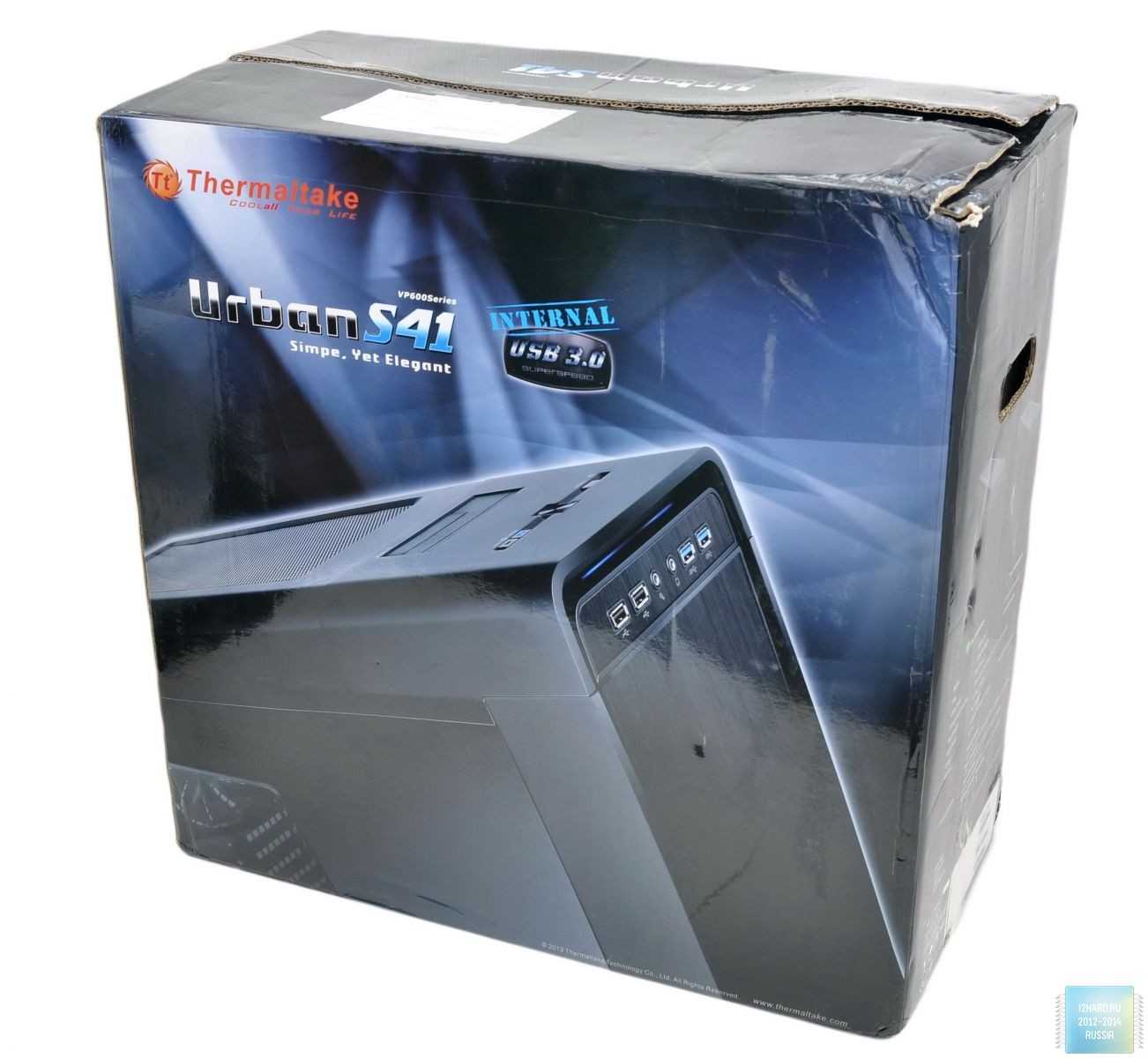
Список с краткими техническими характеристиками и основными особенностями корпуса расположены на боковых сторонах коробки.
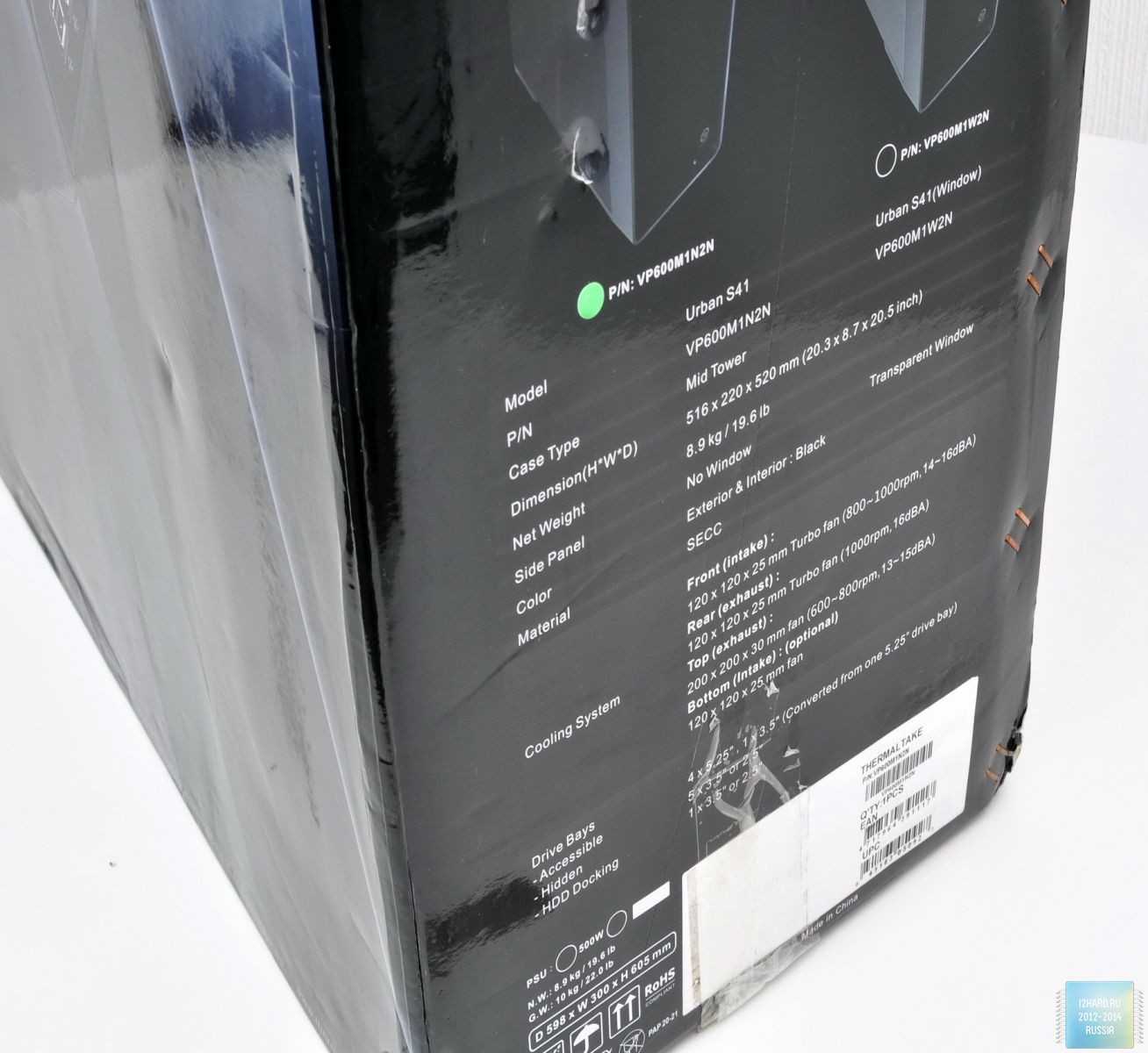
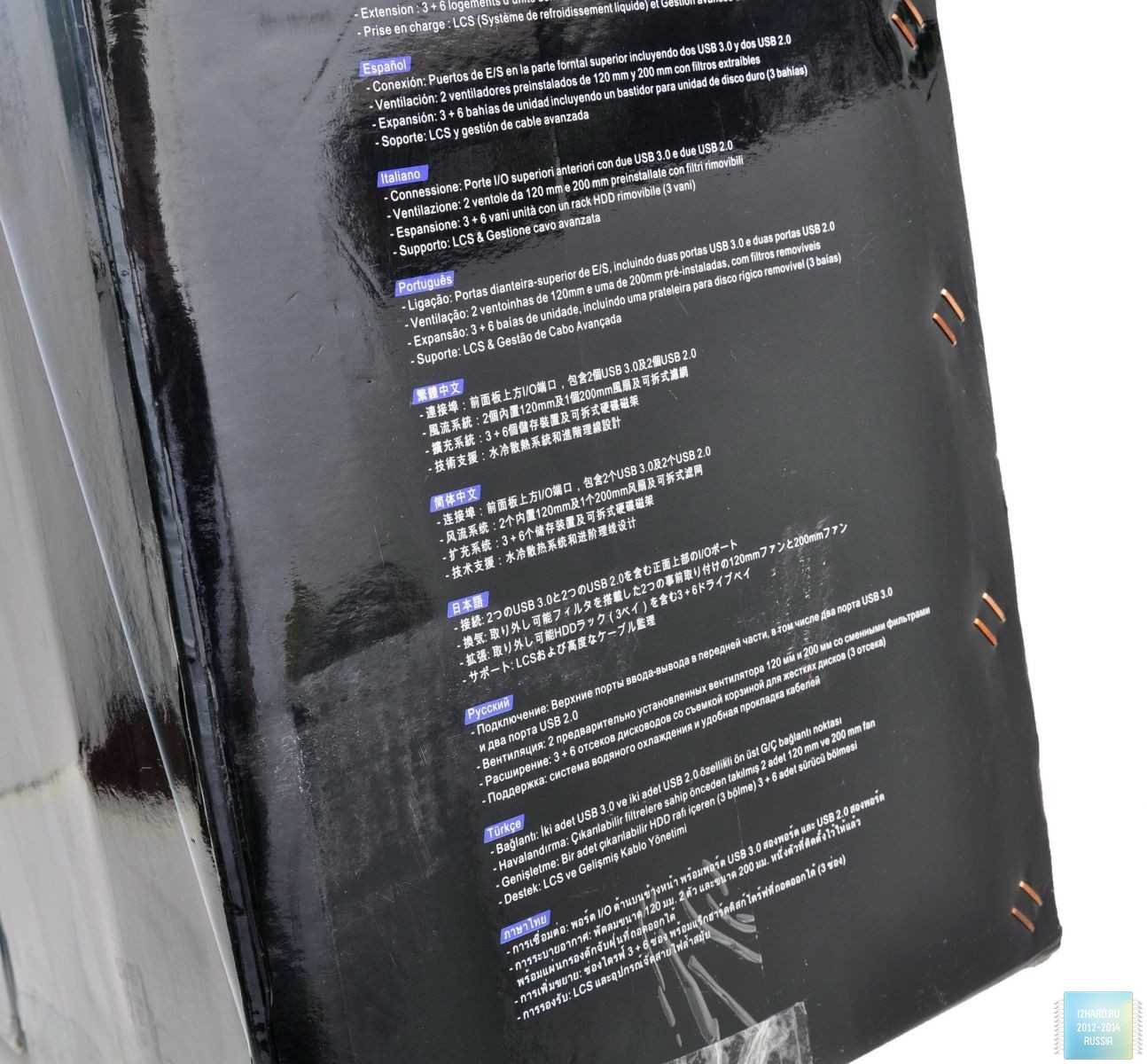
В комплекте поставки, помимо самого корпуса, входят:
- гарантийный талон и подробная инструкция по эксплуатации;
- диагностический динамик;
- пластиковые стяжки 5 шт;
- салазки для установки одного 3,5″ устройства в 5,25″ отсек 2 шт;
- винты для накопителей формата 3,5″ 20 шт;
- винта для блока питания 4 шт;
- стойка для материнской платы 1 шт;
- винты для устройств 2,5″, 5,25″ 28 шт;
- винты для материнской платы и переходника отсека 5,25″ 14 шт.




























